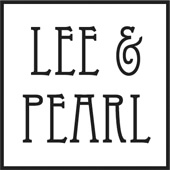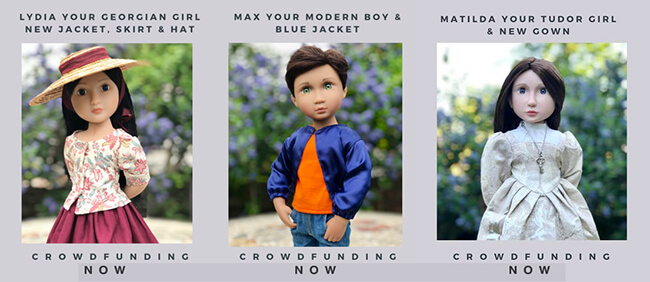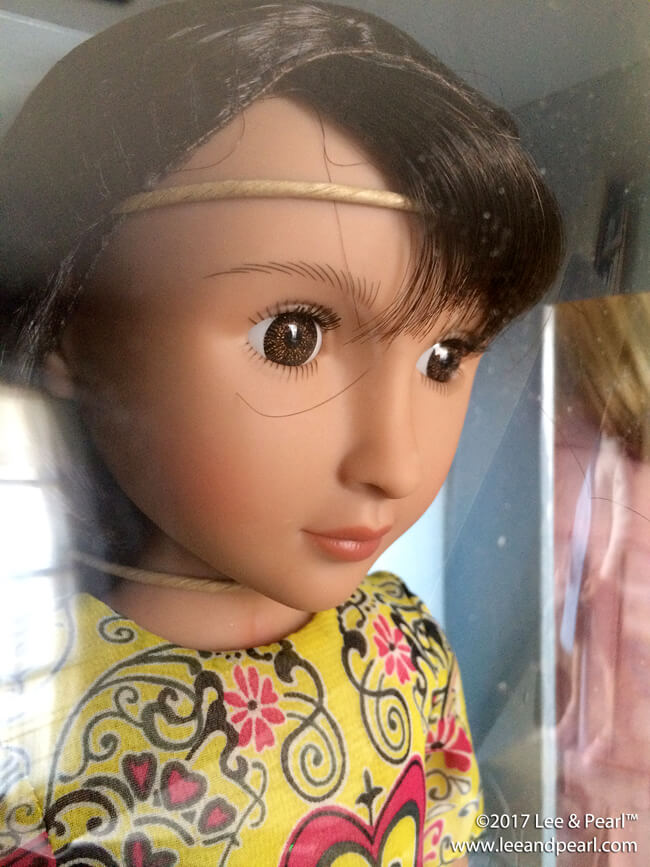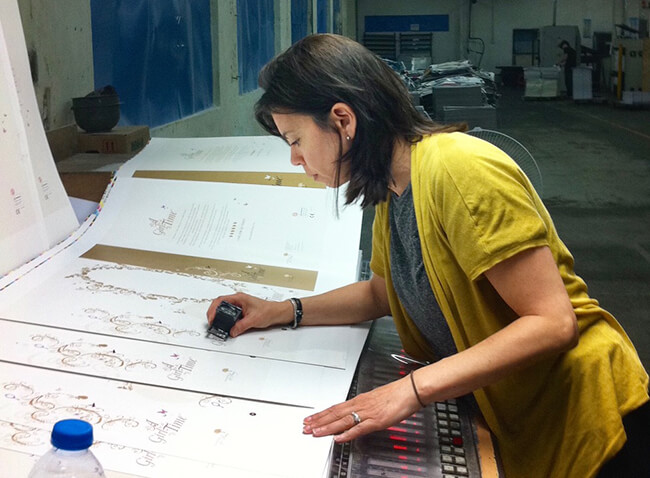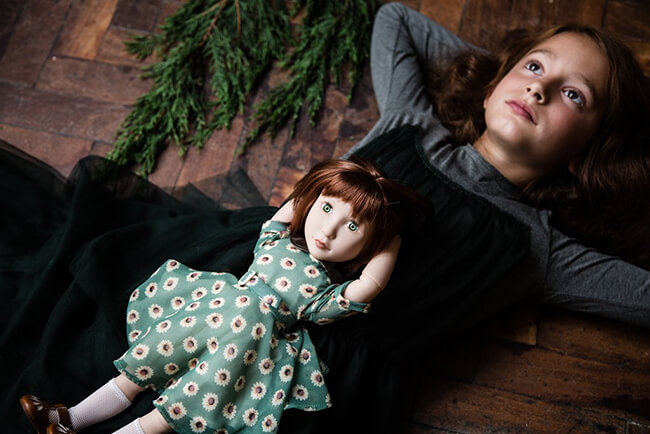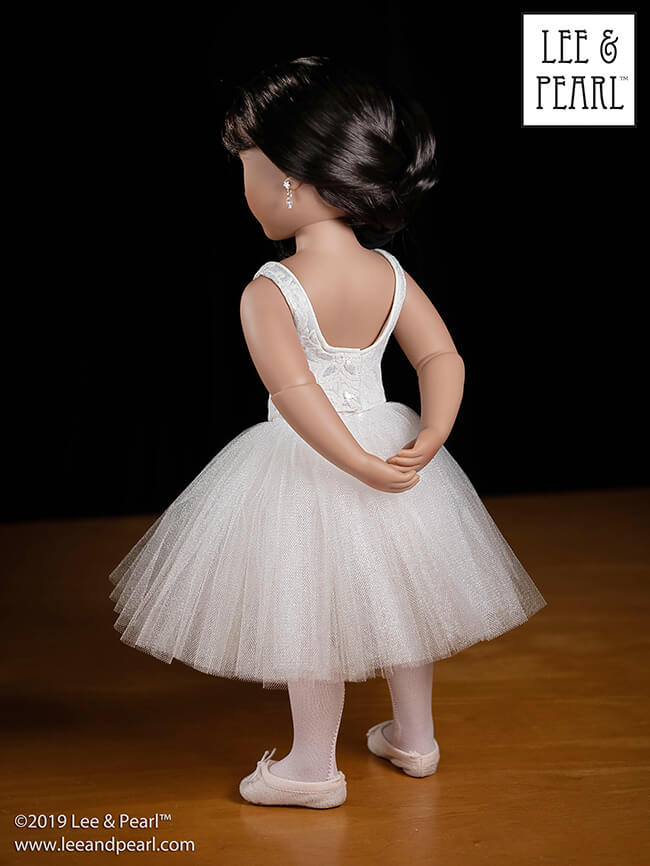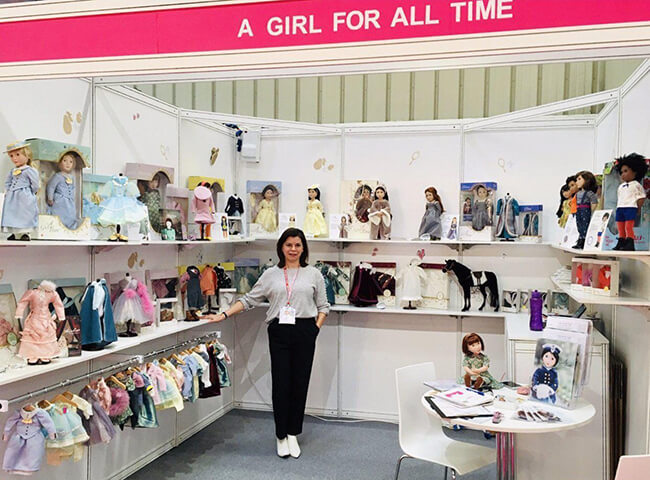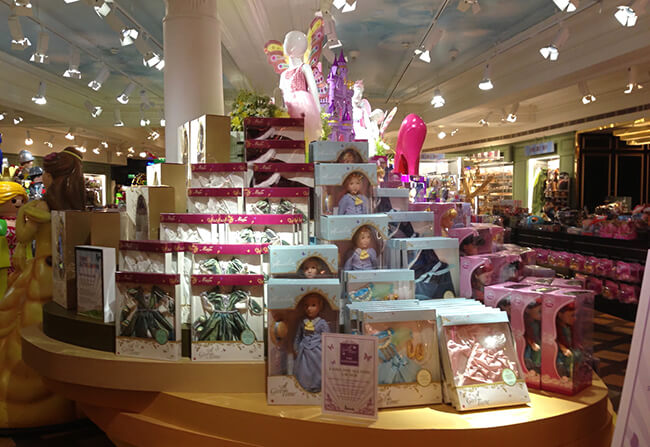June 13, 2019
Meet the Dollmaker — an interview with Frances Cain, creator of the A Girl for All Time® line of 16 inch historical and modern play dolls.
We are so excited about the subject of this newsletter!
We first met Frances Cain at Toy Fair in New York City back in 2012. We fell in love with her beautiful dolls — on display at the Fair for the first time — and we were enchanted by their creator as well.
Frances is a true visionary in the toy industry. Born in the United States, she now lives and works in London, where she created A Girl for All Time® and continues to build it into the vibrant, award-winning doll company we all love today.
Frances is currently running a LIMITED TIME ONLY crowdfunding campaign on the A Girl for All Time website, with steep discounts offered on pre-orders of the newest member of her 16 inch doll tribe — Max, Your Modern Boy™ — and re-issues of two popular, sold-out historical dolls — Lydia, Your Georgian Girl™ and Matilda, Your Tudor Girl™ — with new outfits and accessories available as well.
CLICK HERE TO VISIT THE A GIRL FOR ALL TIME WEBSITE AND SHOP THE LIMITED TIME ONLY CROWDFUNDING SALE!
While Frances is hard at work designing new dolls and running her sale, we're hard at work re-imagining and re-designing our collection of 18 inch doll patterns for her lovely 16 inch girls — and that new boy.
CLICK HERE TO VISIT THE 16 INCH / A GIRL FOR ALL TIME DOLL-SIZE PATTERN SECTION IN THE LEE & PEARL ETSY STORE
In fact, we'll be debuting a NEW pattern for these dolls next week, so keep an eye on your email inboxes for that announcement. And if you aren't already a Lee & Pearl mailing list member, be sure to SIGN UP HERE.
Between the limited-time-only crowdfunding sale and our new pattern release, this seemed the perfect time to have a virtual sit-down with our favorite toymaker. We know that a lot of you — our mailing list friends — collect and sew for these dolls, so last week, we asked if you had any questions for Frances.
Oh boy, did you guys come through with some GREAT questions. You truly made this interview a joy to put together. Thank you!
So set aside your pins and needles, make yourself a pot of tea, and let's get chatting with the amazing Frances Cain...
Frances, welcome to the Lee & Pearl newsletter and our first "Meet the Dollmaker" feature!
We're going to jump right in with our biggest question — what was your inspiration to start this journey with A Girl for All Time®?
I think my lightbulb moment was when I was sitting with friends, and we were discussing how difficult it was to buy a present for our daughters and friends of daughters, whose age bracket at the time was about 7-8 years and above. Every time I went to the toy store to get gifts for friends’ children or my own, my options for girls’ gifts seemed to be either plastic makeup or things that had no depth to them, while options for boys included games or action figures with maths or logic and strategy or even "make this paper model based on a drawing of Leonardo da Vinci." It seemed very imbalanced to me and I thought girls needed toys that celebrated their femininity, but with depth and thought behind them.
We couldn't agree more, and had similar reasons for establishing Lee & Pearl.
But that's such a big step — actually diving into toy manufacturing because you see a gap in what's being offered. Nadeen W. would like to know what prompted you to go into the doll business in particular, and we'd love to know why you chose to focus on historical dolls. Did you have a background in toys and manufacturing — or literature and history?
This is a good question. To be honest, I had zero experience in manufacturing or toy design before having children. I had been in event management, and my ability to multi-task on an extreme level and bring dozens and dozens of different processes together at one point — the event — really helped me manage design, manufacturing and sales successfully.
But it was my love of history that pulled me into the toy business. I studied both Art History and History at university and was lucky that both sides of my family were mad about family trees. So for me creating something that would help children learn about their own family stories seemed like an interesting challenge — and of course what better way to illustrate a family tree than to use dolls?
It is a truly charming concept — the idea that all the girls in your historical line belong to the same family tree, even if they live in different eras and sometimes different countries, and have very different lives.
You've explored so many wonderful eras and places with that Marchmont family: the 16th century Tudor and Elizabethan courts with Matilda and Elinor, the 18th century American colonial period with Lydia, the late Victorian era with Amelia, the 1940s with Clementine and the swinging '60s with Sam. Do you personally have a favorite era, or an era you’re just dying to explore next through the dolls?
For me most historical periods are fascinating and not always because of the "big" events that occurred at the time. It’s the day to day life during that those periods that I find so interesting.
I think the 1920s would be a great period to really dive into. Both my grandmothers had some great stories about the '20s but their experiences could not have been further apart. One was a socialite and a flapper on the east coast and the other was an immigrant from Sicily living in Chicago. Two different worlds, lots of amazing stories, as you can imagine!
That sounds incredible — and intriguing. On that note, Mary H. would like to know if there are more historical dolls planned?
Yes, definitely more historical dolls planned! We have a lot of plans for future growth, and have designs waiting to be added to both our historical and contemporary ranges.
That is great news. So... any thoughts about the male side of the Marchmont family tree? Susan E. would like to know if you’ve considered adding a boy doll to the historical line?
Definitely, yes. We have lots of ideas for boy characters and costumes as well and it’s great to see that there is so much more interest in having boy dolls. I think it’s great to see how that’s changed over the last few years!
While we're on the subject of doll inspirations, Patricia D. and Anna S. would love to know what dolls you had when you were growing up.
Of course I had Barbie dolls growing up, and my dad was a bit of a forward thinking feminist in the late '60s so he used to help me dress them up in tin foil (aluminium foil for the Brits!) so that I could pretend they were astronauts. My mother got me started on collecting Madame Alexander dolls — the ones from different countries — and those dolls, which I still have, first inspired my interest in travel and other cultures.
And then my grandmother gave me a gorgeous doll she bought in Italy when I was ten. Her name was Bella and I thought she was just gorgeous. I still have her as well, though she is looking a little worse for wear!
Speaking of gorgeous dolls — from the first moment we saw your booth at Toy Fair, we have been in love with your dolls and their marvelous, soulful faces.
I don't know if most people realize how remarkable it is that you launched an entirely new doll line with more than one face mold — and quite a few more at that. As a reminder, the American Girl® line launched with a single face mold, and they went on using that one mold for every doll for six years. I can't even think of another play doll company that has done anything like your level of individual design, right from the start.
On that subject, Barb K. would like to know if you design each of those face molds personally. And Barb, Cathie P. and Judy A. would all like know more about how the molds are designed.
I work with the illustrator at the very beginning of the process, and then work directly with our sculpt house in the Far East. I sit with the wax artist in his studio and we go over every detail of every sculpt until I am happy with the result. So I personally have input at every stage of design and I am the final sign-off on not only all the costumes and accessories, but also all the face sculpts.
The molds are actually quite a long process. First we work with a very talented illustrator here in the UK and we discuss the character we want to develop — personality traits, era she lives in, those kind of things. And then we get a first sketch and work on developing more details from there. Once we have a 2-dimensional image we love, we send it to our design team in the Far East who scan the entire image into a CAD (computer aided design) scan. This process takes a 2D image and turns it into a computerized 3D image. The original 2D drawing will have over 300 points mapped out on it in order to turn it into a 3D image, so it’s a very precise process and takes time to get right. If the points are mapped incorrectly, we have a mess of a CAD scan!
That 3D image is then uploaded into a very specialized computer-driven sculpting machine and a large square block of wax is inserted. The computer then removes all of the wax that is not part of the design. It’s different than sculpting the face out of the wax, if that makes sense. The excess wax is actually removed, leaving you with your prototype wax sculpt.
Then we go in and make alterations by hand. This is extremely time consuming and can take days to do. This is the stage where only the human eye can ascertain what looks good and what does not.
After we have finalized those hand-crafted details, the wax sculpt is encased in bronze, and the wax is melted out of the sculpt, leaving us with an "inside out" master mold.
From here we make dozens of sets of production molds and this is what is used for the manufacturing process. Liquid vinyl is poured into those production molds, rotated until each mold is equally coated with vinyl, cooled to the exact correct temperature and them pulled from the mold. We then add the eyes and hair and hand paint the faces.
Wow, that sounds incredible. Is there any special inspiration for the doll faces? We know our mother based her puppet faces on our baby faces, is there a similar hidden inspiration in your line?
We really wanted to create something that older children might gravitate towards, something between a dream world and the real world. Part fantasy, part imagination. We have not based the sculpts on any actual person or faces.
So, how do you choose the mold for each doll? I think you mentioned that each doll’s personality is part of the process...?
Definitely! The personality of each doll informs the sculpt. One of the things we hear again and again is how each character seems to have her own personality. This is one of the unique attributes of A Girl for All Time I think, and it's so wonderful to hear from our customers that all of our hard work on creating these different personalities shines through in the dolls.
It definitely does. Thank you for putting all that work into their face molds.
You briefly mentioned eyes and hair, so let's talk about those as well. Nadeen W. would love to know where you get your ideas for hair and eye color combinations.
We usually have an idea of what hair and eye color we will use at the illustration point of the process, so really from day one. However the actual process for choosing hair and eye color is quite intricate. We spend a lot of time on those selections. Each character has at least 3 different hair colors in her wig, with different percentages of each, so that the hair is multi-dimensional, like real human hair.
Eye color is in general already determined at the illustration stage, but choosing the right shade and eye decoration take a few prototypes before we get it looking perfect. So while we have a good idea of what we want, we do have to go through a few tests in order to get it just right!
Several of our friends asked about your feelings on long hair vs. short hair on dolls. It's almost a given that little girls all want long, flowing locks while their moms prefer short, easy-care hairstyles. And as a patternmaker, I have to admit that short-haired Clementine and Sam go into heavy rotation when it's testing time. But then again, long hair is more accurate for the pre-20th century historical dolls, which we also love.
I think it's been great seeing how dolls have evolved since we we’ve launched. There are more boy dolls, more diverse dolls. I remember when we launched Clementine, I had a very major retailer here in the UK tell me that red-headed dolls don’t sell, especially ones with short hair — and Clementine is one of our best sellers! So perceptions have changed and I like to think that we have been in front of those changes. Bex has natural short curly hair, Clem has straight short hair, Maya has shorter hair with a wave to it and Sam’s hair is straight with bangs. So lots of choices, lots of hair options!
Thank you for that.
Now let's talk about the dolls' graceful, jointed bodies. Nadeen W. would like to know how you decided on the doll measurements, and we’d like to know, too — was the 16 inch size choice inspired in some way?
I remember when we launched, I don’t think there was anything other than 18 inch dolls — and people asked why in the world would I have something that wasn’t 18 inch? I remember replying that it was because I did not want to be just another 18 inch doll. We were going to be different from the outset. I think the size is a good one for children to carry around, and I feel that a 16 inch doll is perfect for older children who still want dolls but don’t want "baby" dolls.
I have to admit, we were among those a little unsure about the new size. We loved everything else about the dolls, but 18 inch had become such a standard that we couldn't quite wrap our heads around anything else. Which is silly, since 18 inch wasn't a standard size when American Girl launched.
In the time since, we've come to see that the 16 inch size was an inspired choice, both for the height and for the more realistic and slightly older-looking proportions. These dolls are a ton of fun to dress. They wear clothes — both historical and modern — absolutely beautifully. So you can go ahead and call Lee and Pearl 16 inch converts!
And of course, the jointed bodies make them so expressive in play scenes and photographs.
Speaking of those jointed bodies, Cathie P. and Barbara G. (the Doll Doctor) would like to know how the joint mechanisms were chosen and designed. Barbara would also like to know about repairing them, though she has yet to have one come in for repairs!
A-ha, well I am so glad that none of them have had to come in for repairs! That is good to know. Our joints are a traditional stringing system. We looked for a long time at ball jointed but for a 16 inch doll we felt that it added too much expense to the overall manufacturing cost.
We worked closely with our sculpt house to get the hands and the feet just right as well as we wanted the dolls to be poseable and be playable.
I can attest that they really do stand beautifully, even though the feet have realistic-looking arches and toes and all that. So, job well done.
Now let's talk about the clothes! Noel D. would like to know how you research and decide on your designs and what inspires you to create them? Noel would also like to know about design prototypes and planning outfits for manufacture abroad.
The road to making a doll — dressed, boxed and ready to sell — is a very long one.
We start the process here in the UK by researching the era of the doll we want to create. One of the great things about doing the research here is the amount of original resources we have on hand. For example, when we decided we wanted to do a Tudor doll, access to original portraits at the National Gallery and clothing and everyday articles like traveling trunks at the British Museum and Hever Castle made the research an absolute joy for someone like me who loves social history.
We used this sort of primary source, initial research to create mood boards for each character. From there, we started collecting modern-day materials. I source prototype fabrics for the garments and accessories here in the UK — and then we take those prototypes to the Far East and try and source the closest matched fabrics we can. Usually, I go and do the sourcing myself with a translator. It’s exhausting but it is loads of fun — and it gives me a head start on ideas for any upcoming characters, too.
Next, each and every fabric, thread, trim and fastener we use has to be safety tested. We test color fastness, heavy metals safety (think metalic sparkles in some fabrics, or even the silver snaps used to close a top or as decoration on a shoe), and more. We test everything to make sure that fabrics don't unravel, shred, catch fire... you name it, we test it.
This is a very costly process so we cannot test fabrics until we know we are going into production. We try to source materials as similiar as possible to our prototypes, but quite often they have to be changed or tweaked for fabrics that can pass every one of our tests.
The final doll costumes have gone through a long process and have undergone quite a few changes before you actually get to see them on the website!
Wow. That reminds us of the scene in The Devil Wears Prada where Meryl Streep explains all the choices that have to be made before a single blue sweater can show up on a clothing store rack. On that note, let's talk about what it's really like to be the woman behind an international toy company.
Anna S. would like to know how long it takes to go from concept to an actual doll, ready to sell.
Anywhere from 18-36 months, depending on lots of factors, some of them quite dull like exchange rates!
Sandra S. asks, as this is the real world and we know everything hasn’t gone smoothly from the first moment you thought, "Hey! I’d like to design a doll for one era in history and then follow her family line to present day" — how long has it actually taken to reach this level of success?
Yikes, that is a good question. It was about two years of research and prototype design and really struggling to find the right manufacturing partners before we could do a soft launch in late 2011 — with our first trade show Jan 2012. Since then it's been a lot of hard work identifying the right sales channels, finding out where and who our customers are and how best to reach them, and adjusting our sales and marketing for each country we sell into. And of course things change, sometimes very quickly, so it's a constant learning process of how to market, where to market, and to whom to market. We can't sit on our laurels and are constantly looking to see where we can improve.
Cathie P. would like to know what has been your biggest business challenge.
Wow, another good question! Every year has had its challenges, to be honest and some of them are no different than what every working parent experiences — health issues, conflicting schedules with the kids or spouse / partner — but some of them are unique to having an international business. Specifically, things like the effects of Brexit on small businesses, the new Chinese tariffs coming from the USA, exchange rate fluctuations due to both those things, increased costs of raw materials, supply chain challenges… these are things I don’t have much control over but have a huge impact on the business.
If you don't mind answering, Sandra S. would like to know what was your lowest point in the journey — and how did you climb back up?
I’d say a personal low was actually the week that I launched the brand at Toy Fair London in 2012, because that very week I was diagnosed with breast cancer. It came out of the blue and was totally unexpected. The next two years were spent trying to promote the business and have treatment. It’s not something I ever want to go through again, but in a way having the business was a great distraction and it is amazing what you can get through if you put your mind to it.
Wow, we first met you at Toy Fair in New York in 2012, and we would never have known that you were going through anything other than a super-successful doll brand launch. Thank you for sharing something so real, and so inspirational with us. Without indie manufacturers like you, the toy industry would be pretty bleak these days. So we really want to thank you for working through any challenges and continuing to put out beautiful dolls, accessories and books.
We know how important it is to have support — a team, even — when dealing with those unpredictable challenges. Can you tell us about your team? Have they been with you from the start and was it essential to have certain people in place before you launched?
Most of the team has been on board since the start. Even though Sandra [writer/director Sandra Goldbacher] has been more and more in demand over the years, shooting films and television series for Netflix, the BBC and Amazon, she always finds time for character development and story arcs for the dolls.
Pete [filmmaker Pete Salmi] is our go-to for brand graphics and illustrations — and we still work with the same illustrator for our initial doll sculpt designs. Our team in the Far East has also remained the same. My project manager and my head of quality control are my bedrocks and I could not manage the intricate designs we produce without them!
Speaking of Sandra, Mary G. would like to know if there will be more historical books for the dolls in the future?
More books are definitely in the works! Running a publishing arm in addition to the manufacturing part of the biz takes a lot of time and resources, and for the moment we are focused on product — dolls and costumes. But books are definitely in the pipeline, with further plans to expand beyond novels.
Beyond novels? That sounds intriguing... we might have to circle back to that question next year.
Who do you turn to for advice and support?
For anything creative the first person I turn to is Sandra. She is brilliant at listening to ideas and picking apart concepts and making them cohesive. My husband is the one I turn to for the more "boring" advice — financial structure, funding, operations. He also has a very strong entrepreneurial streak himself and has been involved with a half dozen startups in his own field, so it’s great to bounce things off of someone who has been there, done that.
Now let's talk about the other crucial side of any business — the customers.
On the various doll Facebook groups and elsewhere on the internet, we mostly see input from adult collectors — for legal and privacy reasons, of course. So we’re likely getting a distorted view of the average consumer. Do you see the dolls mostly as play dolls or as collector dolls?
The dolls were originally conceived as play dolls, so it was a surprise and a delight to see the collector world embrace the brand as they have.
Alla A. would like to know if you have any statistics you could share on who is actually playing with your dolls?
It’s difficult to get stats on something like that as we can't really ask each customer at the point of purchase who the item is for. But we have done a survey or two and they support what I’ve thought was the market split — about 65% play dolls for children, with the rest likely collectors.
I think we're all happy to know that real girls are getting to play with these wonderful dolls. Alla also asks if you have any thoughts about clubs or ways to get kids even more involved in playing with real and not just digital toys?
That’s a good question. I’m really keen on "analog" play but realize that digital is definitely a part of most kids' play experience today — so we have lots of tutorials and craft ideas on the website, with the goal to get kids offline and playing.
Let's talk about the best ways to reach customers in this new digital world. We mentioned your current crowdfunding campaign at the start of this newsletter (everybody go buy Max). You are self-hosting that campaign, and in the past, you've worked with other crowdfunding platforms as well. This seems an intriguing way to support small manufacturers in these days of heavy and unpredictable regulatory and cross-border costs — but wonderful online connectivity. What have your experiences been with the different campaigns and platforms?
Both Indiegogo and Kickstarter were good experiences, though very different ones. Kickstarter has less flexibility than Indiegogo, at least for what I needed to do with it, but both gave the brand great exposure to people who might now have known about us before. There are a lot of restrictions within those platforms for a growing business however — launching multiple products or multiple campaigns throughout the year is not possible with either of those platforms, which for a growing brand like ours was too restricting right now. Having said that, it does not mean that I would not do another campaign on one of those platforms — they definitely are fabulous if you have the right campaign for their platform.
What are the benefits to self-hosting?
Self-hosting has a lot of benefits for a growing brand. We can launch multiple campaigns all at once and we have better control over the time frame. We can even extend a campaign deadline if we need to, which you can’t do on the other commercial platforms!
Again, we're really intrigued by the idea of crowdfunding indie manufacturing. So, if you don't mind, I've grabbed some of the text from your website explaining the benefits to both the consumers and the company of this type of pre-production financing:
Why are we crowdfunding?
The answer is simple.
- Crowdfunding saves you money. The price of a product is usually calculated by adding up the costs of manufacturing, importing, marketing, advertising and long term storage. Purchasing during a crowdfunding campaign means we don't incur marketing, advertising and long term storage costs so we can pass those savings directly on to YOU, giving you the best price possible for your purchase.
- Crowdfunding means no one is disappointed because an item is ‘sold out‘. Knowing how many units we need to manufacture before we place the order at our factory means that no one loses out. As long as we meet our campaign's funding goal, every person who buys through our crowdfunding campaign will be guaranteed a doll.
Well, we've reached the end of our mailing list members' questions, and our own questions. So at this point, we want to thank Frances — and remind everyone that the time is growing short to take part in her current A Girl for All Time crowdfunding campaign.
That crowdfunding campaign is scheduled to end in less than a week, on June 19, 2019.
So if you are interested in Max or Lydia or Matilda or any of their gorgeous outfits or accessories, hurry on over to the A Girl for All Time website before June 19th and place your order!
CLICK HERE TO VISIT THE A GIRL FOR ALL TIME CROWDFUNDING PAGE TO SEE MAX AND ALL THE OTHER NEW OFFERINGS BEFORE THE CAMPAIGN ENDS AND YOU LOSE YOUR CHANCE!
Want pattern announcements, tutorials, interviews and behind-the-scenes news from Lee & Pearl delivered directly to your inbox — along with our exclusive FREE pattern for subscribers, The Gift Bow Front Dress for 18 inch, 16 inch and 14 1/2 inch dolls? Click below to join our mailing list!
CLICK HERE to sign up for the Lee & Pearl mailing list.
See you next time...
— back to the Newsletter Archive —
![]()
